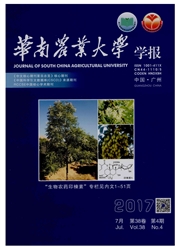

 中文摘要:
中文摘要:
通过整蚕(蛹)石蜡切片甲基绿-派罗宁和孚尔根染色的方法对变态期家蚕中肠、丝腺的形态结构进行显微观察.试验结果表明,家蚕中肠变态过程中肠腔内出现大量无定形细胞团块,这些细胞团块有2个来源,一是由肠壁再生细胞向内不断分生新的一簇簇细胞,这些成簇的细胞团逐渐与肠壁分离脱落进肠腔形成无定形团块;二是肠壁内折,形成内陷,内陷外围细胞又重新粘合生长成新的肠壁,被包在肠腔内的内陷细胞变成了无定形团块.蛹变态期,随着吐丝的进行,丝腺内部的丝物质逐渐排空,体积不断缩小,外膜褶皱逐渐增加,细胞内空泡不断增多,细胞核由分枝状逐渐变成束状,再浓缩成团状,最后发生溶解、消亡.
 英文摘要:
英文摘要:
Using the methods of parafine-mounted sectioning and staining by methyl green-pyronine and feulgen, the morphology and structure of midgut and silk-gland of silkworm, Bombyx mori, were observed by microscopy during metamorphosis. The experiment showed that there were a lot of amorphous cell-hke conglomeration inside the intestine. There were two ways which formed these conglomeration. First, old epithelium of midgut fell off into the intestine gradually while the regenerative cells on the base proliferated and formed into the new epidermic cell of papue. Second, parts of the old epidermis sank into the intestine and became the amorphous cell-like conglomeration, which was the main reason that the midgut shrunk increasingly. During the spinning, the material of silk decreased gradually and the bulk became lessening and thin. When the spin finished, silk gland changed remarkably, and the ectoblast of silkgland draped. There were increasing vesicles inside the cell of silk gland. Branch-liked nucleus changed into bunchs and then condensed into agglomerates. Finally, it degenerated and died out completely.
 同期刊论文项目
同期刊论文项目
 同项目期刊论文
同项目期刊论文
 期刊信息
期刊信息
